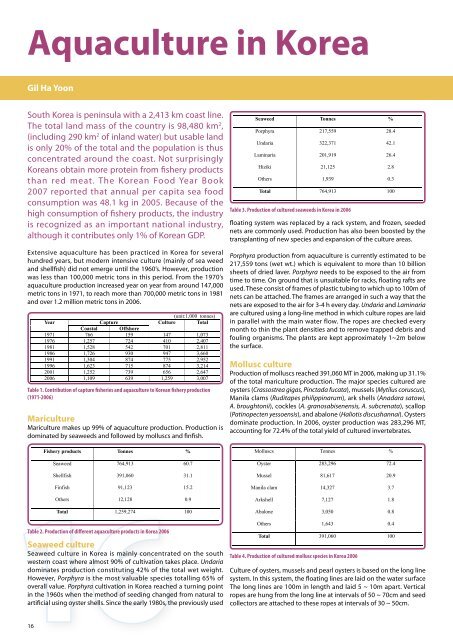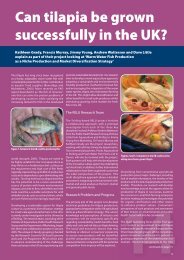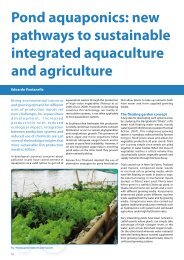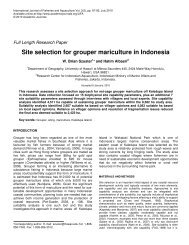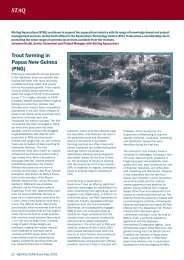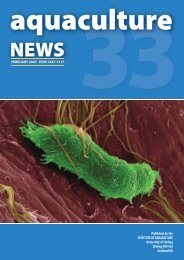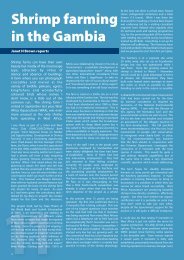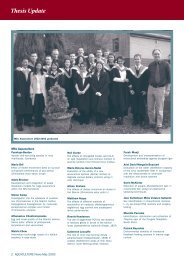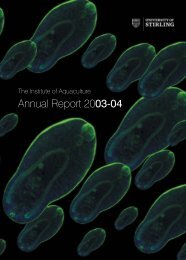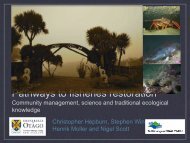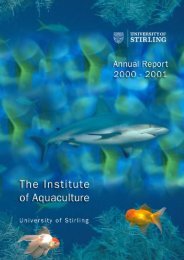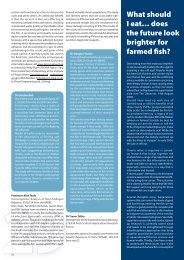Aquaculture in Korea: Gil Ha Yoon
Aquaculture in Korea: Gil Ha Yoon
Aquaculture in Korea: Gil Ha Yoon
Create successful ePaper yourself
Turn your PDF publications into a flip-book with our unique Google optimized e-Paper software.
Seaweed culture<br />
<strong>Aquaculture</strong> <strong>in</strong> <strong>Korea</strong><br />
Seaweed culture <strong>in</strong> <strong>Korea</strong> is ma<strong>in</strong>ly concentrated on the south western coast where<br />
almost 90% of cultivation takes place. Undaria dom<strong>in</strong>ates production constitut<strong>in</strong>g 42%<br />
of the total wet weight. However, Porphyra is the most valuable species totall<strong>in</strong>g 65% of<br />
overall value. Porphyra cultivation <strong>in</strong> <strong>Korea</strong> reached a turn<strong>in</strong>g po<strong>in</strong>t <strong>in</strong> the 1960s when<br />
<strong>Gil</strong> <strong>Ha</strong> <strong>Yoon</strong><br />
South <strong>Korea</strong> is pen<strong>in</strong>sula with a 2,413 km coast l<strong>in</strong>e.<br />
The total land mass of the country is 98,480 km 2 ,<br />
(<strong>in</strong>clud<strong>in</strong>g 290 km 2 of <strong>in</strong>land water) but usable land<br />
AQUACULTURE IN KOREA<br />
is only 20% of the total and the population is thus<br />
South <strong>Korea</strong> is pen<strong>in</strong>sula with a 2,413 km l<strong>in</strong>e. The total land mass of the<br />
concentrated around the coast. Not surpris<strong>in</strong>gly<br />
country is 98,480 km<br />
<strong>Korea</strong>ns obta<strong>in</strong> 2 , (<strong>in</strong>clud<strong>in</strong>g 290 km<br />
more prote<strong>in</strong> 2 of <strong>in</strong>land water) but usable land is only 20%<br />
from fishery products<br />
of the total and the population is thus concentrated around the coast. Not surpris<strong>in</strong>gly<br />
than red meat. The <strong>Korea</strong>n Food Year Book<br />
2007 <strong>Korea</strong>ns reported obta<strong>in</strong> more prote<strong>in</strong> that from fishery annual products than per red meat. capita The <strong>Korea</strong>n sea Food food Year<br />
consumption Book 2007 reported that was annual 48.1 per capita kg sea <strong>in</strong> food 2005. consumption Because was 48.1 kg of <strong>in</strong> 2005. the<br />
high Because of the high consumption of of fishery products, products, the <strong>in</strong>dustry the is recognized <strong>in</strong>dustry as an<br />
is important recognized national <strong>in</strong>dustry, as although an important it contributes only 1% national of <strong>Korea</strong>n GDP. <strong>in</strong>dustry,<br />
although it contributes only 1% of <strong>Korea</strong>n GDP.<br />
Extensive aquaculture has been practiced <strong>in</strong> <strong>Korea</strong> for several hundred years, but modern<br />
Extensive aquaculture has been practiced <strong>in</strong> <strong>Korea</strong> for several<br />
<strong>in</strong>tensive culture (ma<strong>in</strong>ly of sea weed and shellfish) did not emerge until the 1960's.<br />
hundred years, but modern <strong>in</strong>tensive culture (ma<strong>in</strong>ly of sea weed<br />
and However, shellfish) production did was not less emerge than 100,000 until metric the 1960’s. tons <strong>in</strong> this However, period. From production<br />
the 1970's<br />
was<br />
aquaculture<br />
less than<br />
production<br />
100,000<br />
<strong>in</strong>creased<br />
metric<br />
year on<br />
tons<br />
year from<br />
<strong>in</strong> this<br />
around<br />
period.<br />
147,000<br />
From<br />
metric tons<br />
the<br />
<strong>in</strong><br />
1970’s<br />
1971,<br />
aquaculture production <strong>in</strong>creased year on year from around 147,000<br />
metric to reach tons more <strong>in</strong> than 1971, 700,000 to metric reach tons more <strong>in</strong> 1981 than and over 700,000 1.2 million metric tons <strong>in</strong> 2006. 1981<br />
and over 1.2 million metric tons <strong>in</strong> 2006.<br />
Table 1. Contribution of capture fisheries and aquaculture to <strong>Korea</strong>n fishery<br />
production (1971-2006)<br />
(unit:1,000 tonnes)<br />
Year<br />
Capture<br />
Culture Total<br />
Coastal Offshore<br />
1971 766 159 147 1,073<br />
1976 1,257 724 410 2,407<br />
1981 1,528 542 701 2,811<br />
1986 1,726 930 947 3,660<br />
1991 1,304 874 775 2,952<br />
1996 1,623 715 874 3,214<br />
2001 1,252 739 656 2,647<br />
2006 1,109 639 1,259 3,007<br />
Table 1. Contribution of capture fisheries and aquaculture to <strong>Korea</strong>n fishery production<br />
(1971-2006) 1. Mariculture<br />
Mariculture makes up 99% of aquaculture production. Production is dom<strong>in</strong>ated by<br />
Mariculture<br />
seaweeds and followed by molluscs and f<strong>in</strong>fish.<br />
Mariculture makes up 99% of aquaculture production. Production is<br />
dom<strong>in</strong>ated by seaweeds and followed by molluscs and f<strong>in</strong>fish.<br />
Table 2. Production of different aquaculture products <strong>in</strong> <strong>Korea</strong> 2006<br />
Fishery products Tonnes %<br />
Seaweed 764,913 60.7<br />
Shellfish 391,060 31.1<br />
1616<br />
Seaweed culture<br />
F<strong>in</strong>fish 91,123 15.2<br />
Others 12,128 0.9<br />
Total 1,259,274 100<br />
Table 2. Production of different aquaculture products <strong>in</strong> <strong>Korea</strong> 2006<br />
Seaweed culture<br />
Seaweed culture <strong>in</strong> <strong>Korea</strong> is ma<strong>in</strong>ly concentrated on the south western coast where<br />
Seaweed culture <strong>in</strong> <strong>Korea</strong> is ma<strong>in</strong>ly concentrated on the south<br />
western<br />
almost 90%<br />
coast<br />
of cultivation<br />
where almost<br />
takes place.<br />
90%<br />
Undaria<br />
of cultivation<br />
dom<strong>in</strong>ates production<br />
takes<br />
constitut<strong>in</strong>g<br />
place. Undaria<br />
42%<br />
dom<strong>in</strong>ates of the total wet production weight. However, constitut<strong>in</strong>g Porphyra is the 42% most valuable of the species total totall<strong>in</strong>g wet weight. 65% of<br />
However, Porphyra is the most valuable species totall<strong>in</strong>g 65% of<br />
overall value. Porphyra cultivation <strong>in</strong> <strong>Korea</strong> reached a turn<strong>in</strong>g po<strong>in</strong>t <strong>in</strong> the 1960s when<br />
Porphyra cultivation <strong>in</strong> <strong>Korea</strong> reached a turn<strong>in</strong>g po<strong>in</strong>t<br />
<strong>in</strong> the method 1960s of seed<strong>in</strong>g when changed the method from natural of seed<strong>in</strong>g to artificial changed us<strong>in</strong>g oyster from shells. natural S<strong>in</strong>ce the to<br />
artificial us<strong>in</strong>g oyster shells. S<strong>in</strong>ce the early 1980s, the previously used<br />
early 1980s, the previously used float<strong>in</strong>g system was replaced by a rack system, and<br />
frozen, seeded nets are commonly used. Production has also been boosted by the<br />
transplant<strong>in</strong>g of new species and expansion of the culture areas.<br />
the method of seed<strong>in</strong>g changed from natural to artificial us<strong>in</strong>g oyster shells. S<strong>in</strong>ce the<br />
early 1980s, the previously used float<strong>in</strong>g system was replaced by a rack system, and<br />
Table 3. Production of cultured seaweeds <strong>in</strong> <strong>Korea</strong> <strong>in</strong> 2006<br />
Seaweed Tonnes %<br />
Porphyra 217,559 28.4<br />
Undaria 322,371 42.1<br />
Lam<strong>in</strong>aria 201,919 26.4<br />
Hiziki 21,125 2.8<br />
Others 1,939 0.3<br />
Total 764,913 100<br />
Table 3. Production of cultured seaweeds <strong>in</strong> <strong>Korea</strong> <strong>in</strong> 2006<br />
float<strong>in</strong>g system was replaced by a rack system, and frozen, seeded<br />
nets are commonly used. Production has also been boosted by the<br />
transplant<strong>in</strong>g of new species and expansion of the culture areas.<br />
Porphyra production from aquaculture is currently estimated to be<br />
217,559 tons (wet wt.) which is equivalent to more than 10 billion<br />
sheets of dried laver. Porphyra needs to be exposed to the air from<br />
time to time. On ground that is unsuitable for racks, float<strong>in</strong>g rafts are<br />
used. These consist of frames of plastic tub<strong>in</strong>g to which up to 100m of<br />
nets can be attached. The frames are arranged <strong>in</strong> such a way that the<br />
nets are exposed to the air for 3-4 h every day. Undaria and Lam<strong>in</strong>aria<br />
are cultured us<strong>in</strong>g a long-l<strong>in</strong>e method <strong>in</strong> which culture ropes are laid<br />
<strong>in</strong> parallel with the ma<strong>in</strong> water flow. The ropes are checked every<br />
month to th<strong>in</strong> the plant densities and to remove trapped debris and<br />
foul<strong>in</strong>g organisms. The plants are kept approximately 1~2m below<br />
the surface.<br />
Mollusc culture<br />
Production of molluscs reached 391,060 MT <strong>in</strong> 2006, mak<strong>in</strong>g up 31.1%<br />
of the total mariculture production. The major species cultured are<br />
oysters (Crassostrea gigas, P<strong>in</strong>ctada fucata), mussels (Mytilus coruscus),<br />
Manila clams (Ruditapes philipp<strong>in</strong>arum), ark shells (Anadara satowi,<br />
A. broughtonii), cockles (A. granosabisenensis, A. subcrenata), scallop<br />
(Pat<strong>in</strong>opecten yessoensis), and abalone (<strong>Ha</strong>liotis discushannai). Oysters<br />
dom<strong>in</strong>ate production. In 2006, oyster production was 283,296 MT,<br />
account<strong>in</strong>g for 72.4% of the total yield of cultured <strong>in</strong>vertebrates.<br />
Table 4. Production of cultured mollusc species <strong>in</strong> <strong>Korea</strong> 2006<br />
Molluscs Tonnes %<br />
Oyster 283,296 72.4<br />
Mussel 81,617 20.9<br />
Manila clam 14,327 3.7<br />
Arkshell 7,127 1.8<br />
Abalone 3,050 0.8<br />
Others 1,643 0.4<br />
Total 391,060 100<br />
Table 4. Production of cultured mollusc species <strong>in</strong> <strong>Korea</strong> 2006<br />
Culture of oysters, mussels and pearl oysters is based on the long l<strong>in</strong>e system. In this<br />
Culture system, the of oysters, float<strong>in</strong>g l<strong>in</strong>es mussels are laid on and the pearl water surface oysters The is long based l<strong>in</strong>es are on 100m the long <strong>in</strong> length l<strong>in</strong>e<br />
system. In this system, the float<strong>in</strong>g l<strong>in</strong>es are laid on the water surface<br />
The and long laid 510m l<strong>in</strong>es are apart. 100m Vertical <strong>in</strong> ropes length are hung and from laid the 5 ~ long 10m l<strong>in</strong>e apart. at <strong>in</strong>tervals Vertical of<br />
ropes are hung from the long l<strong>in</strong>e at <strong>in</strong>tervals of 50 ~ 70cm and seed<br />
5070cm and seed collectors are attached to these ropes at <strong>in</strong>tervals of 30 50cm.<br />
collectors are attached to these ropes at <strong>in</strong>tervals of 30 ~ 50cm.<br />
Bottom culture is employed for molluscs such as arkshells and Manila clams. The<br />
parameters affect<strong>in</strong>g site selection <strong>in</strong>clude water depth, water temperature, algal foods
Ra<strong>in</strong>bow trout farm<br />
was 91,123 tonnes, 15% of total mar<strong>in</strong>e production, but because of<br />
trends <strong>in</strong> consumption <strong>in</strong> <strong>Korea</strong>, f<strong>in</strong>fish culture is the most valuable<br />
aquaculture production. The highest production of cultured fish<br />
was from olive flounder (48.1%), followed by black rockfish (30.2%),<br />
sea breams (9.6%) and grey mullet (6.2%). Although culture of olive<br />
flounder started only <strong>in</strong> the late 1980s, <strong>Korea</strong>n production exceeded<br />
that of Japan by 1997.<br />
Olive flounder is reared <strong>in</strong> land-based raceway culture systems where<br />
water is pumped ashore.<br />
Farms are usually located on the south and west coasts and each farm<br />
usually produces on average about 110 tonnes per year with mean<br />
stock<strong>in</strong>g densities of 20kg/m 3 . Other fish species such as sea breams<br />
or mullet are grown <strong>in</strong> float<strong>in</strong>g cages or enclosures. Cage cultures<br />
are more common. The cages are 5m x 5m or 10m x 10m <strong>in</strong> size and<br />
stocked with 700-1000 juveniles per m 3 at a length of 4cm to 5cm.<br />
Cage farms for f<strong>in</strong>fish culture near the shore<br />
Cage farms for f<strong>in</strong>fish culture near the shore<br />
Bottom culture is employed for molluscs such as arkshells and Manila<br />
clams. and Acanthopagrus The parameters schlegeli, affect<strong>in</strong>g and grey mullet, site selection Mugil cephalus, <strong>in</strong>clude have been water important depth,<br />
water<br />
mar<strong>in</strong>e<br />
temperature,<br />
f<strong>in</strong>fish cultured s<strong>in</strong>ce<br />
algal<br />
the<br />
foods<br />
late 1980s.<br />
and<br />
F<strong>in</strong>fish<br />
bottom<br />
production<br />
substrate.<br />
<strong>in</strong> 2006 was<br />
Normally,<br />
91,123<br />
water depths for bottom culture are less than 20m for most species<br />
but<br />
tonnes,<br />
arkshells<br />
15% of total<br />
are<br />
mar<strong>in</strong>e<br />
cultured<br />
production,<br />
below<br />
but<br />
the<br />
because<br />
<strong>in</strong>tertidal<br />
of trends <strong>in</strong><br />
zone<br />
consumption<br />
down<br />
<strong>in</strong><br />
to<br />
<strong>Korea</strong>,<br />
40m<br />
depth.<br />
f<strong>in</strong>fish culture is the most valuable aquaculture production. The highest production of<br />
cultured fish was from olive flounder (48.1%), followed by black rockfish (30.2%), sea<br />
F<strong>in</strong>fish<br />
With breams the (9.6%) development and grey mullet of (6.2%). advanced Although aquaculture of olive flounder technology, started only olive <strong>in</strong><br />
flounder, the late 1980s, Paralichthys <strong>Korea</strong>n production olivaceus, exceeded together that of Japan with by black 1997. rockfish, Sebastes<br />
schlegeli, sea breams, Pagrus major and Acanthopagrus schlegeli,<br />
and grey mullet, Mugil cephalus, have been important mar<strong>in</strong>e<br />
f<strong>in</strong>fish cultured s<strong>in</strong>ce the late 1980s. F<strong>in</strong>fish production <strong>in</strong> 2006<br />
Table 5. Production of cultured f<strong>in</strong>fish <strong>in</strong> <strong>Korea</strong> 2006<br />
F<strong>in</strong>fish Tonnes %<br />
Olive flounder 48,852 48.1<br />
Rock fish 27,517 30.2<br />
Sea breams 8,777 9.6<br />
Grey mullet 5,651 6.2<br />
Freshwater culture<br />
Freshwater culture represents only 1% of total <strong>Korea</strong>n aquaculture<br />
production. Eel ponds were first constructed <strong>in</strong> 1924 near Busan,<br />
but the operation was discont<strong>in</strong>ued <strong>in</strong> the 1940’s. A further attempt<br />
was made <strong>in</strong> 1966 <strong>in</strong> Noksan, Kimhae, near Busan, us<strong>in</strong>g wild elvers.<br />
The ra<strong>in</strong>bow trout was first <strong>in</strong>troduced <strong>in</strong>to <strong>Korea</strong> <strong>in</strong> 1965, but the<br />
annual production rema<strong>in</strong>ed negligible (below 10 tonnes) until<br />
1980. Production then <strong>in</strong>creased reach<strong>in</strong>g 704 tonnes <strong>in</strong> 1987 and<br />
more than 5000 tonnes <strong>in</strong> 2006. The ma<strong>in</strong> area of trout production is<br />
Gangwon-do, where relatively large amounts of upland cool spr<strong>in</strong>g<br />
water are available. In some sites ground water is used.<br />
<strong>Korea</strong> has traditionally been a seafood exporter but <strong>in</strong>creas<strong>in</strong>g<br />
domestic demand and decreased local production means <strong>Korea</strong><br />
currently imports $ 1.7 billion more seafood products than it exports.<br />
It is unlikely that <strong>Korea</strong>n capture fisheries will be <strong>in</strong>creased due to<br />
stock depletion and that aquaculture will be <strong>in</strong>creas<strong>in</strong>gly important.<br />
However, the <strong>Korea</strong>n aquaculture <strong>in</strong>dustry also faces problems such<br />
as natural disasters (typhoons and red tides), low price imported<br />
products and lack of highly skilled manpower. To circumvent these<br />
problems there will be expansion of offshore culture sites, and<br />
<strong>in</strong>creas<strong>in</strong>g use of automated management systems.<br />
Sea bass 1,571 1.7<br />
Others 4,090 4.5<br />
Total 91,123 100<br />
Table 5. Production of cultured f<strong>in</strong>fish <strong>in</strong> <strong>Korea</strong> 2006<br />
Olive flounder is reared <strong>in</strong> land-based raceway culture systems where water is pumped<br />
ashore.<br />
Farms are usually located on the south and west coasts and each farm usually produces on<br />
average about 110 tonnes per year with mean stock<strong>in</strong>g densities of 20kg/ m3 . Other fish<br />
species such as sea breams or mullet are grown <strong>in</strong> float<strong>in</strong>g cages or enclosures. Cage<br />
cultures are more common. The cages are 5m x 5m or 10m x 10m <strong>in</strong> size and stocked with<br />
Ra<strong>in</strong>bow trout farm<br />
Ra<strong>in</strong>bow trout farm<br />
17<br />
Submerged nets for sea weed culture<br />
<strong>Aquaculture</strong> News 34 / May 2008 17<br />
Submerged nets for sea weed culture


